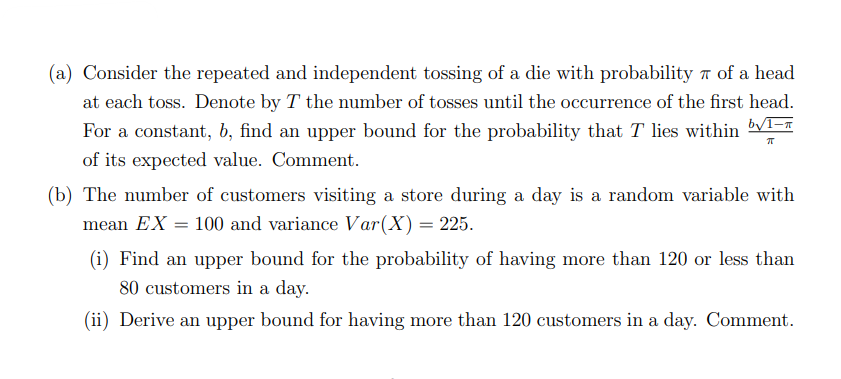(a) Consider the repeated and independent tossing of a die with probability 7 of a head at each toss. Denote by T the number of tosses until the occurrence of the first head. For a constant, b, find an upper bound for the probability that T lies within V1-T of its expected value. Comment. (b) The number of customers visiting a store during a day is a random variable with mean EX = 100 and variance Var(X) = 225. (i) Find an upper bound for the probability of having more than 120 or less than 80 customers in a day. (ii) Derive an upper bound for having more than 120 customers in a day. Comment.
(a) Consider the repeated and independent tossing of a die with probability 7 of a head at each toss. Denote by T the number of tosses until the occurrence of the first head. For a constant, b, find an upper bound for the probability that T lies within V1-T of its expected value. Comment. (b) The number of customers visiting a store during a day is a random variable with mean EX = 100 and variance Var(X) = 225. (i) Find an upper bound for the probability of having more than 120 or less than 80 customers in a day. (ii) Derive an upper bound for having more than 120 customers in a day. Comment.
A First Course in Probability (10th Edition)
10th Edition
ISBN:9780134753119
Author:Sheldon Ross
Publisher:Sheldon Ross
Chapter1: Combinatorial Analysis
Section: Chapter Questions
Problem 1.1P: a. How many different 7-place license plates are possible if the first 2 places are for letters and...
Related questions
Question

Transcribed Image Text:(a) Consider the repeated and independent tossing of a die with probability 7 of a head
at each toss. Denote by T the number of tosses until the occurrence of the first head.
For a constant, b, find an upper bound for the probability that T lies within V1-T
of its expected value. Comment.
(b) The number of customers visiting a store during a day is a random variable with
mean EX = 100 and variance Var(X) = 225.
(i) Find an upper bound for the probability of having more than 120 or less than
80 customers in a day.
(ii) Derive an upper bound for having more than 120 customers in a day. Comment.
Expert Solution
This question has been solved!
Explore an expertly crafted, step-by-step solution for a thorough understanding of key concepts.
Step by step
Solved in 4 steps with 4 images

Recommended textbooks for you

A First Course in Probability (10th Edition)
Probability
ISBN:
9780134753119
Author:
Sheldon Ross
Publisher:
PEARSON


A First Course in Probability (10th Edition)
Probability
ISBN:
9780134753119
Author:
Sheldon Ross
Publisher:
PEARSON
